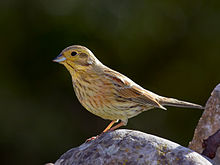| Cirl bunting | |
|---|---|

| |
| Male | |

| |
| Female | |
| Scientific classification | |
| Domain: | Eukaryota |
| Kingdom: | Animalia |
| Phylum: | Chordata |
| Class: | Aves |
| Order: | Passeriformes |
| Family: | Emberizidae |
| Genus: | Emberiza |
| Species: | E. cirlus
|
| Binomial name | |
| Emberiza cirlus Linnaeus, 1766
| |

| |
| Geographic distribution shown in green | |


The cirl bunting (/ˈsɜːrl/ SURL),[2] (Emberiza cirlus), is a passerine bird in the bunting family Emberizidae, a group now separated by most modern authors from the finches, Fringillidae.
It breeds across southern Europe, on the Mediterranean islands and in north Africa. It is a resident of these warmer areas, and does not migrate in winter. It is common in all sorts of open areas with some scrub or trees, but has a preference for sunny slopes. In the 19th century it was introduced to New Zealand and the persistent population remains in the South Island.[3]
Changes in agricultural practice have affected this species very adversely at the northern fringes of its range, and in England, where it once occurred over much of the south of the country, it is now restricted to south Devon. The cirl bunting is the mascot on the signs for the village of Stokeinteignhead in Devon.
- ^ BirdLife International (2018). "Emberiza cirlus". IUCN Red List of Threatened Species. 2018: e.T22720888A132004013. doi:10.2305/IUCN.UK.2018-2.RLTS.T22720888A132004013.en. Retrieved 12 November 2021.
- ^ The RSPB: Projects: The Cirl Bunting Project
- ^ Angus, D. J. 2013 [updated 2015]. Cirl bunting. In Miskelly, C.M. (ed.) New Zealand Birds Online. www.nzbirdsonline.org.nz
